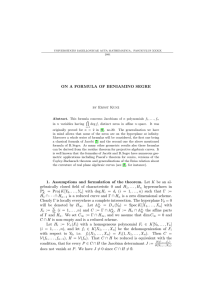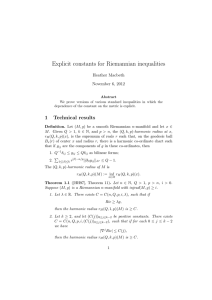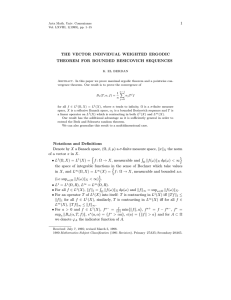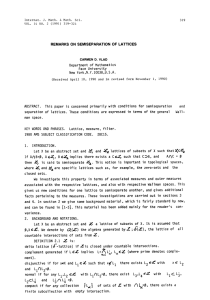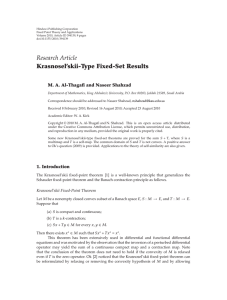LOCAL PROPERTIES OF MAPS OF THE BALL
advertisement
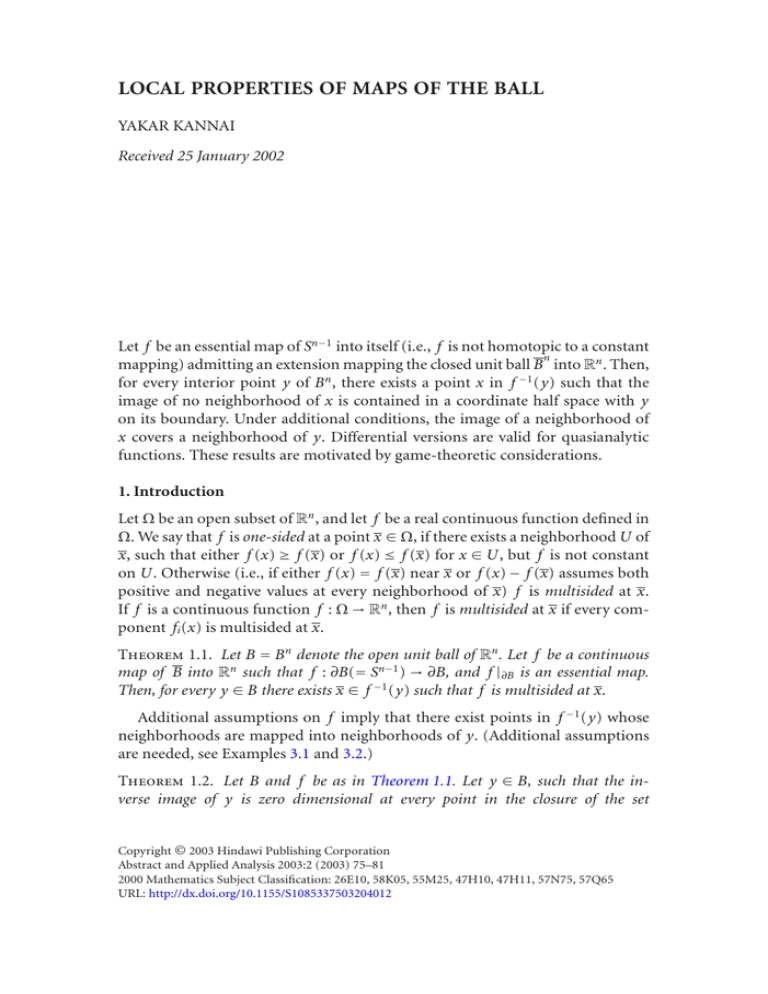
LOCAL PROPERTIES OF MAPS OF THE BALL
YAKAR KANNAI
Received 25 January 2002
Let f be an essential map of Sn−1 into itself (i.e., f is not homotopic to a constant
n
mapping) admitting an extension mapping the closed unit ball B into Rn . Then,
n
−1
for every interior point y of B , there exists a point x in f (y) such that the
image of no neighborhood of x is contained in a coordinate half space with y
on its boundary. Under additional conditions, the image of a neighborhood of
x covers a neighborhood of y. Differential versions are valid for quasianalytic
functions. These results are motivated by game-theoretic considerations.
1. Introduction
Let Ω be an open subset of Rn , and let f be a real continuous function defined in
Ω. We say that f is one-sided at a point x ∈ Ω, if there exists a neighborhood U of
x, such that either f (x) ≥ f (x) or f (x) ≤ f (x) for x ∈ U, but f is not constant
on U. Otherwise (i.e., if either f (x) = f (x) near x or f (x) − f (x) assumes both
positive and negative values at every neighborhood of x) f is multisided at x.
If f is a continuous function f : Ω → Rn , then f is multisided at x if every component fi (x) is multisided at x.
Theorem 1.1. Let B = Bn denote the open unit ball of Rn . Let f be a continuous
map of B into Rn such that f : ∂B(= Sn−1 ) → ∂B, and f |∂B is an essential map.
Then, for every y ∈ B there exists x ∈ f −1 (y) such that f is multisided at x.
Additional assumptions on f imply that there exist points in f −1 (y) whose
neighborhoods are mapped into neighborhoods of y. (Additional assumptions
are needed, see Examples 3.1 and 3.2.)
Theorem 1.2. Let B and f be as in Theorem 1.1. Let y ∈ B, such that the inverse image of y is zero dimensional at every point in the closure of the set
Copyright © 2003 Hindawi Publishing Corporation
Abstract and Applied Analysis 2003:2 (2003) 75–81
2000 Mathematics Subject Classification: 26E10, 58K05, 55M25, 47H10, 47H11, 57N75, 57Q65
URL: http://dx.doi.org/10.1155/S1085337503204012
76
Local properties of maps of the ball
{x : x ∈ f −1 (y), f is multisided at x}. Then there exists x ∈ f −1 (y) such that for
every open neighborhood U of x, f (U) contains an open neighborhood of y.
There exists differential (actually, quasianalytic) versions of the preceding
concepts. Let M = M j be a logarithmically convex sequence of positive numbers.
Let V be an open subset of Rk , where k is arbitrary. The class CM (V ) consists of
those functions f in C ∞ (V ) such that for every compact K ⊂ V there exists constants A and B such that for every multi-index α, the inequality
α
∂ f (x) ≤ AB |α| M|α|
(1.1)
[3] states
holds whenever x ∈ K. The well-known Denjoy-Carleman theorem
that the class CM (V ) is quasianalytic if and only if the series ∞
j =1 M j −1 /M j
diverges. Following [2], we may consider CM manifolds, in particular we consider CM curves, that is, curves which possess a parametric representation x(t) =
(x1 (t),...,xn (t)), such that the functions xi (t) are in the class CM , for all 1 ≤ i ≤ n.
A scalar function f ∈ CM (Ω) is CM one-sided at a point x ∈ Ω if
(i) there exists a CM curve x(t) such that x(0) = x, and f (x(t)) is not locally
constant at t = 0,
(ii) for every CM curve x(t) such that x(0) = x, either
(1) the first nonvanishing derivative of f (x(t)) (with respect to t at
t = 0) is of even order and is positive or
(2) the first nonvanishing derivative of f (x(t)) is of even order and is
negative or
(3) f (x(t)) ≡ f (x).
If f → Rn , f ∈ CM , and the function fi (x) is CM one-sided at x for no 1 ≤ i ≤ n
is, we say that f is CM multisided at x.
The relation between ordinary one-sidedness and CM one-sidedness is spelled
out in the following proposition.
Proposition 1.3. Let f be a scalar function, f ∈ CM (Ω). Then, f is one-sided at
x ∈ Ω if and only if f is CM one-sided at x.
The proof of Proposition 1.3 depends on the desingularization results of
Bierstone and Milman [2]. The proposition implies immediately the following
version of Theorem 1.1.
Theorem 1.4. Let B and f be as in Theorem 1.1, and let f ∈ CM (B). Then there
exists x ∈ f −1 (y) such that f is CM multisided at x.
Note that the boundary behavior of f along with quasianalyticity imply that
no component fi of f is locally constant at any point. As seen in Example 3.3,
we do not have a CM strengthening of Theorem 1.2.
Observe that Proposition 1.3 and Theorem 1.4 are valid if, instead of assuming that M is a Denjoy-Carleman class, we assume that M = C(Ω), where the
collection of algebras C(U) (U runs over all open subsets of Rm , m arbitrary)
Yakar Kannai 77
satisfies conditions (3.1), (3.2), (3.3), (3.4), (3.5), and (3.6) of [2]. As a matter of
fact, only these assumptions are needed for the validity of the desingularization
results in [2].
The motivation for the study of multisidedness comes from recent results
on set-valued maps of the closed simplex ∆ (see [4]), results which have gametheoretic applications. For example, it is shown that under certain conditions,
if F is a set-valued map from ∆ to the convex subsets of ∆, then for every y ∈
int(∆), there exists x, such that y is in the relative interior of F(x) (see [4, Theorem 1]). If in addition, the closure of the set {x : y ∈ relint(F(x))} is zero dimensional, then there exists x ∈ int(∆) such that y ∈ int(F(x)) (see [4, Theorem
2]). The purpose of this paper is to find a single-valued analog of the results of
[4]. The proofs of Theorems 1.1 and 1.2 here are similar in spirit to the proofs
of Theorems 1 and 2 in [4], respectively. In [4], the maps are not deformed continuously (as in the present paper); instead, certain neighborhoods of the origin
are removed from the values of the (set-valued) maps. The weaker conclusion
in Theorem 1.1 as well as the slightly weaker zero-dimensionality assumption
in Theorem 2 of [4] are compensated by a certain finiteness assumption made
in [4].
Note that, Theorems 1.1 and 1.4 continue to hold, if we replace the standard
base of Rn by any other basis v1 ,...,vn , write f as ni=1 fˆi (x)vi , and define onesidedness and multisidedness using the functions fˆi . (This was pointed out by
I. Yomdin (personal communication).)
Note that, unlike the situation in Sard’s theorem, Theorem 1.1 applies to all
points y ∈ B.
2. Proofs
Let f satisfy the assumptions of Theorem 1.1, and let y be an arbitrary point
of B. We may assume, without loss of generality (to simplify notation a bit), that
y = 0. Let x be a point in Di = fi−1 (0) ∩ B. Let Ci+ (Ci− ) denote the set of points
x ∈ Di for which there exists a neighborhood U of x in which fi (x) ≥ 0 ( fi (x) ≤
0), but fi (x) is not a constant in U (i.e., fi (x) does not vanish identically in U).
Set Ni = fi−1 (−∞,0) and Pi = fi−1 (0, ∞). For any set A, let ρ(x,A) denote the
distance of x from A (= inf y∈A |x − y |). We now deform the map f as follows:
for every t ≥ 0, set
ft (x) = f1 (x,t),..., fn (x,t) ,
(2.1)
where
fi (x,t) = fi (x) + tρ(x,∂B) ρ x,Ni − ρ x,Pi
for 1 ≤ i ≤ n.
(2.2)
78
Local properties of maps of the ball
Observe that ft (x) ≡ f (x), if x ∈ ∂B. If x ∈ Ci+ ∪ Pi , then ρ(x,∂B) > 0 and
ρ(x,Pi ) = 0. Moreover, fi is nonnegative in a full neighborhood of x. Hence,
ρ(x,Ni )>0. Thus, fi (x,t)> fi (x) ≥ 0 if t > 0. Similarly, if x ∈ Ci− ∪ Ni , then fi (x,t)
< 0 (for positive t). It follows that ft (x) = 0 is possible for t > 0 only if x ∈
f −1 (0)\ ni=1 (Ci+ ∪ Ci− ). But the restriction of ft (x) to the boundary ∂B is essential for positive
t as well, so that the set ft−1 (0) is nonempty. Hence, there exists
n
−1
x ∈ f (0)\ i=1 (Ci+ ∪ Ci− ). This means that for every 1 ≤ i ≤ n, fi (x) = 0, but x
is neither in Ci+ nor in Ci− . This means that either there exists a neighborhood of
x, where fi vanishes identically, or in every neighborhood of x fi assumes both
positive and negative values. Thus, f is multisided at x, proving Theorem 1.1.
In proving Theorem 1.2, we continue to use the notations introduced in the
proof of Theorem 1.1. Assume, without loss of generality, that the set f −1 (0) is
zero dimensional at each point of the closure
of the set F = {x : x ∈ f −1 (0), f is
n
−1
multisided at x}. Note that F = f (0)\ i=1 (Ci+ ∪ Ci− ), and that the deformations defined by (2.1) and (2.2) eliminate all zeros of f outside F without introducing new ones. It is possible, however, that ft (x) will no longer vanish (for
t > 0) on all of F. We modify the deformation by setting
gt (x) = g1 (x,t),...,gn (x,t) ,
(2.3)
where
gi (x,t) = fi (x) + tρ(x,∂B)ρ(x,F) ρ x,Ni − ρ x,Pi
(2.4)
for 1 ≤ i ≤ n.
It is easily seen that gt (x) = 0 if t > 0 and x ∈ F. The assumptions on boundary
behavior imply that for all t ≥ 0, we have
d gt ,B,0 = 0.
(2.5)
(We use standard notation for degree.)
By assumption, the set f −1 (0) is zero dimensional at every point of the compact set F. This implies that for every > 0, the set F may be covered by a finite number of disjoint open sets whose diameter is less than , and whose
boundaries do not meet f −1 (0). Let {Di,m }Pi=m1 denote such a collection of sets
with diam(Di,m ) < 1/m, F ⊆ Pi=m1 Di,m , Di,m ∩ D j,m = ∅ for i = j, and ∂Di,m ∩
f −1 (0) = ∅. By construction, if t ≥ 0, then gt (x) = 0 for all x ∈ ∂Di,m , 1 ≤ i ≤ Pm .
Hence, d(gt ,Di,m ,0) is well defined for all t ≥ 0 and
Pm
d gt ,Di,m ,0 = d gt ,B,0
i=1
(2.6)
Yakar Kannai 79
for all positive t. It follows from (2.5) and (2.6) that there exists i0 = i0 (m)
such that d(g1/m ,Di0 (m),m ,0) = 0. By compactness, there exist a point x ∈ F and
a sequence
Di0 (m),m of neighborhoods (with Di0 (m),m ∩ F compact) such that
x= ∞
m=1 Di0 (m),m . By construction, the degree d(gt ,Di0 (m),m ,0) is independent
of t ≥ 0. For every open neighborhood U of x, there exists a number M such
that the ball around x with radius 1/M is contained in U, so that Di0 (m),m ⊂ U
if m > 2M. It follows that d( f ,Di0 (m),m ,0) = d(g1/m ,Di0 (m),m ,0) = 0. Hence, f (U)
contains a full neighborhood of 0 and Theorem 1.2 follows.
The proof of Proposition 1.3 relies on the results of [2]. We may assume, without loss of generality, that x = 0 and f (0) = 0. Let h(x) be a scalar CM function
in a neighborhood U of the origin, with h(0) = 0 such that h does not vanish
identically in U and h(x) ≥ 0 in U. Let x(t) be an arbitrary CM curve in U such
that x(0) = 0. If there exists a sequence tn → 0, tn = 0, such that h(x(tn )) = 0 for
all n, then the quasianalyticity of h and x implies that h(x(t)) vanishes identically. Otherwise, the function h(x(t)) is strictly positive for small t = 0. Not all
derivative of h(x(t)), with respect to t, vanish at t = 0; the first nonzero one must
be of even order and positive.
It remains to show that, there exist CM curves x(t) such that h(x(t)) does
not vanish identically. This follows from the “curve selection lemma.” We prove
the existence of such curves following Atiyah (see [1, page 147]) and BierstoneMilman [2], and noting that there exists an n-dimensional CM manifold U and
a proper CM map φ from U onto a neighborhood of the origin (contained in
U) such that φ−1 is one to one on {x : h(x) = 0}, and such that h ◦ φ is locally a
monomial times an invertible factor (in suitable coordinates). In particular, we
may choose a (connected) neighborhood W in U and CM coordinates w1 ,...,wn
in W such that φ(0) = 0 and
h φ(w) = g(w)
n
wiki
(2.7)
i=1
for w ∈ W, where the CM function g never vanishes in W, and ki is a nonnegative
integer for 1 ≤ i ≤ n. By assumption, g > 0 in W and the numbers ki are even.
Define a CM curve by x(t) = φ(t,...,t). Then,
h x(t) = g(t,...,t)t
n
i=1 ki
.
(2.8)
Hence h is CM one-sided at 0.
Let h be CM one-sided such that for every CM curve x(t) with x(0) = 0, either the first nonvanishing derivative of h(x(t)) is positive and of even order, or
h(x(t)) = 0. We will show that h is one-sided. If h(x) assumes negative values
in every neighborhood of 0, then either (i) g(0) > 0 and the numbers ki are not
all even, or (ii) g(0) < 0 and all the numbers ki are even. In case (i), suppose
that k1 is odd. Considering the CM curve x(t) = φ(t,0,...,0), we see that h is not
80
Local properties of maps of the ball
CM one-sided. In case (ii), consider the curve x(t) = φ(t,...,t). Then (2.8) holds
with g(0) < 0, contradicting the assumption. It follows that there exists a neighborhood of 0, where h(x) is nonnegative. By assumption, h(x) is not identically
equal to zero. Hence h is one-sided. The case where the first nonvanishing derivative of h(x(t)) is negative, is similar.
Remark 2.1. If f ∈ CM is a vector-valued function such that all components fi
are one-sided, then there exists a CM curve passing through x, such
that for each
1 ≤ i ≤ n not all derivatives of fi (x(t)) vanish at t = 0. (Set h = ni=1 fi .)
3. Examples
Example 3.1. The following function f is multisided at the origin and no fi is
locally constant, but no neighborhood of the origin is mapped onto a full neighborhood of the origin. Set f1 = x1 , f2 = x1 x2 . If (y1 , y2 ) = ( f1 (x1 ,x2 ), f2 (x1 ,x2 ))
and y1 = 0, then y2 = 0, so that no point (0, y2 ) with y2 = 0 is in the image of
f . However, every other line through the origin has points of the image of f on
both sides, arbitrarily close to the origin.
Example 3.2. The assumptions of Theorem 1.1 do not imply the conclusion
of Theorem 1.2. This can be seen by considering the simple one-dimensional
function f (x) = 0 for |x| < 1/2, f (x) = 2x − 1 for 1/2 ≤ x ≤ 1, and f (x) = 2x + 1
for −1 ≤ x ≤ −1/2. Then, f is multisided at |x| < 1/2—a one-dimensional set,
and the conclusion of Theorem 1.2 fails for y = 0.
Example 3.3. The inverse image of a point may consist of a closed analytic curve
even if f is analytic and the assumptions of Theorem 1.2 are satisfied. Let 1/2 >
δ > 0 and set
f1 =
2
2
x1 δ − x1 + x22 − δ 2
,
2
1 − 2δx1
f2 =
2
2
x2 δ − x1 + x22 − δ 2
.
2
1 − 2δx1
(3.1)
Then f −1 (0) is a circle of radius δ centered at (δ,0). The function is one-sided
at every point of the circle except for the origin. The conclusion of Theorem 1.2
holds at the origin. Nevertheless, there exists a curve through the origin on which
both f1 and f2 vanish. Hence, Theorem 1.2 cannot be strengthened (even in the
analytic case) so as to assert that f has a nonvanishing derivative (of a sufficiently
high order) on every analytic curve through x.
Acknowledgments
The work on this paper started at Weizmann and was completed while the author was visiting the University of Minnesota. The author is indebted to E. Bierstone and P. Milman for letting their unpublished work available to him, and to
I. Yomdin for useful discussions.
Yakar Kannai 81
References
[1]
[2]
[3]
[4]
M. F. Atiyah, Resolution of singularities and division of distributions, Comm. Pure
Appl. Math. 23 (1970), 145–150.
E. Bierstone and P. D. Milman, Resolution of singularities in Denjoy-Carleman classes,
http://arxiv.org/abs/math.CV/0108204.
L. Hörmander, The Analysis of Linear Partial Differential Operators. I. Distribution
Theory and Fourier Analysis, Grundlehren der Mathematischen Wissenschaften,
vol. 256, Springer-Verlag, Berlin, 1983.
Y. Kannai and M. H. Wooders, A further extension of the KKMS theorem, Math. Oper.
Res. 25 (2000), no. 4, 539–551.
Yakar Kannai: Department of Mathematics, Weizmann Institute of Science, Rehovot,
Israel
E-mail address: kannai@wisdom.weizmann.ac.il

![5.5 The Haar basis is Unconditional in L [0, 1], 1 < 1](http://s2.studylib.net/store/data/010396305_1-450d5558097f626a0645448301e2bb4e-300x300.png)



